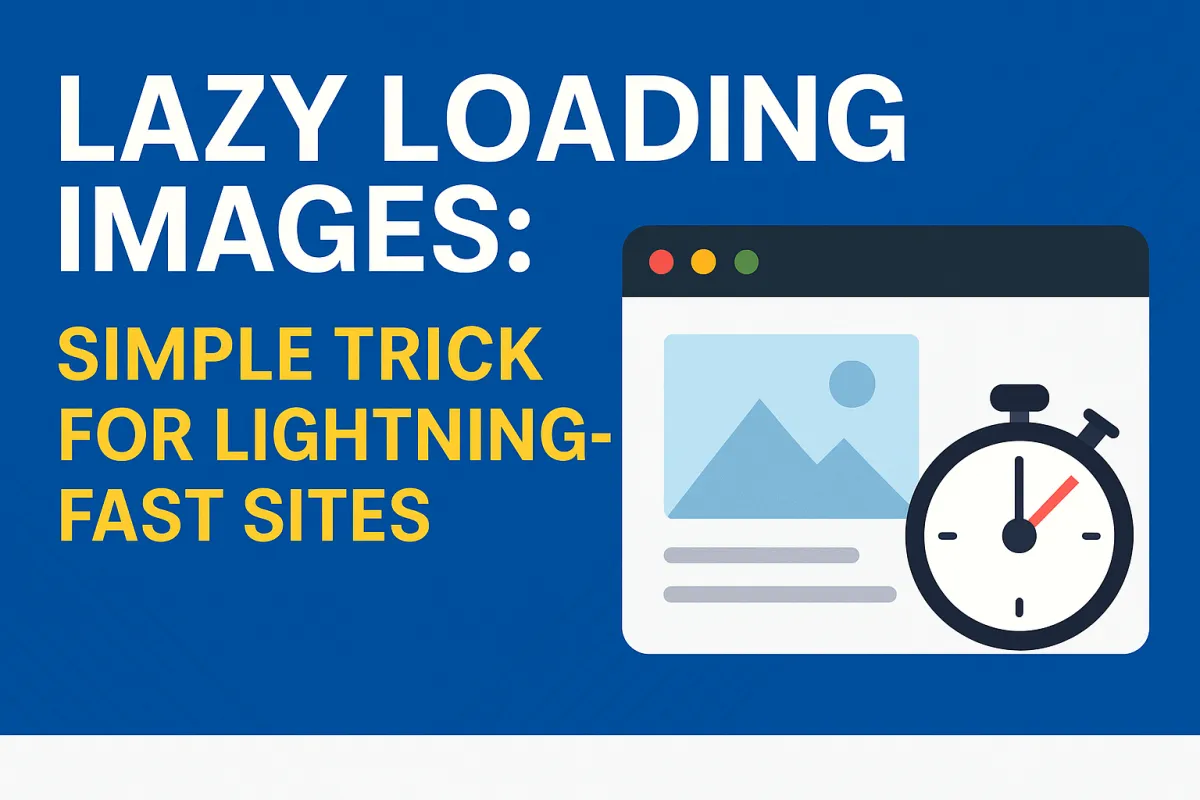
Lazy Loading Images: Simple Trick for Lightning-Fast Sites
Lazy Loading Images: Simple Trick for Lightning-Fast Sites
SEO Title:
Lazy Loading Images: How to Speed Up Your Website Without Hurting SEO
Meta Description:
Boost your site speed and SEO performance with lazy loading. Learn what it is, how it works, best practices, tools, common mistakes, and step-by-step implementation.
Introduction
In a digital world where milliseconds can make millions, how fast your website loads can determine whether you win or lose a customer. According to Google, 53% of mobile users abandon sites that take longer than three seconds to load.
Think about it: even the best content or most compelling offer can be wasted if users bounce before the page even loads. That’s where lazy loading becomes a game-changer—an easy-to-implement technique that speeds up websites while improving SEO and user experience.
This guide will explore what lazy loading is, why it matters, and exactly how to implement it effectively.
Understanding Lazy Loading: Definition and Key Concepts
What Is Lazy Loading?
Lazy loading is a web performance technique that delays the loading of non-critical resources (usually images or videos) until they’re needed—typically when the user scrolls near them. This reduces initial page load time and improves performance.
Rather than loading all assets at once, lazy loading loads only what's needed initially, then defers the rest.
Why It Matters
Faster Time to Interactive (TTI)
Only essential content loads at first, improving usability and first impressions.Lower Bandwidth Consumption
Reduces data usage, especially important for users on mobile or slow connections.Improved SEO via Core Web Vitals
Lazy loading directly impacts Largest Contentful Paint (LCP) and Cumulative Layout Shift (CLS), both critical SEO signals.Better Mobile Experience
Ensures quick and responsive page rendering on mobile devices.
Historical Context and Modern Support
Lazy loading used to require custom JavaScript and manual scroll event listeners, which were error-prone and not SEO-friendly.
Today, lazy loading is natively supported in modern browsers through the simple use of the loading="lazy" HTML attribute. Additionally, developers can use the Intersection Observer API for advanced control.
Why Lazy Loading Is a Game-Changer for Businesses
Faster Load Times = Higher Revenue
Even a one-second delay can reduce conversions by 7%. Lazy loading speeds up critical rendering paths, helping users reach calls-to-action faster.
Enhanced User Experience
Lazy loading prevents layout shifting and "janky" scroll behavior caused by late-loading images, contributing to a smoother UX.
Better SEO and Higher Search Rankings
By improving Core Web Vitals scores, lazy loading contributes to better organic visibility. Implemented correctly, it does not hurt crawlability or indexation.
Real-World Example
Pinterest reduced wait times by 40% after implementing lazy loading and saw a notable increase in user engagement.
Effective Strategies to Master Lazy Loading
1. Audit Current Image Usage
Use tools like Google PageSpeed Insights or GTmetrix to identify unnecessary image loads and opportunities to defer.
2. Implement Native Lazy Loading
Add the loading="lazy" attribute to image elements. Example:
htmlCopyEdit
<img src="image.jpg" loading="lazy" alt="Example image">
3. Use Intersection Observer for Custom Needs
For complex use cases, animations, or staggered loading, implement the Intersection Observer API to trigger lazy loading precisely when content enters the viewport.
4. Optimize Image Formats and Sizes
Convert images to efficient formats like WebP and compress using tools like TinyPNG or ImageOptim. Automate this process if possible via your CMS.
5. Deliver via a CDN
Use a CDN like Cloudflare to serve images faster across geographic regions. This reduces load time and supports SEO through consistent delivery.
6. Centralize Project Management
If working with teams, manage deployment through tools like Notion or ClickUp. Assign tasks, document implementation, and track QA.
7. Monitor and Test Results
Use Google Search Console to ensure images are indexed and Google Analytics to monitor bounce rates, page speed, and engagement metrics.
Common Mistakes to Avoid
Lazy Loading Above-the-Fold Images
Never lazy load images that are visible when the page loads. This hurts LCP, which affects SEO and user experience.
Skipping SEO Metadata
Even lazy-loaded images need descriptive alt attributes and clear filenames for accessibility and search engine indexing.
Overusing JavaScript
Avoid custom scripts unless necessary. They can introduce bugs or compatibility issues. Use native lazy loading whenever supported.
Neglecting Cross-Device Testing
Test lazy loading across browsers (especially Safari) and devices to ensure consistent performance.
Getting Started: Practical Implementation Steps
Step 1: Prepare Your Images
Compress images using Squoosh or TinyPNG
Convert them to modern formats like WebP
Step 2: Add the loading="lazy" Attribute
In your HTML or CMS, update image tags to include lazy loading.
htmlCopyEdit
<img src="image.webp" alt="Optimized photo" loading="lazy">
Step 3: Configure Your CMS or Builder
Platforms like Go HighLevel allow image customization through widgets—make sure lazy loading options are enabled or manually editable.
Step 4: Connect CDN Services
Use Namecheap for DNS management
Set up Cloudflare to cache and optimize image delivery
Step 5: Monitor in Google Tools
Track indexing in Google Search Console
Analyze site speed and bounce rate in Google Analytics
Step 6: Organize Project Tasks
Use Notion or ClickUp to coordinate asset optimization, QA checks, and deployment across your team.
Frequently Asked Questions
Does lazy loading hurt image SEO?
No—if implemented properly with alt text, descriptive filenames, and crawlable HTML, lazy loading supports SEO.
Is lazy loading supported by all browsers?
Most modern browsers like Chrome, Firefox, and Edge support it. For others, use Intersection Observer as a fallback.
Will lazy loading improve Core Web Vitals?
Yes. It improves LCP and CLS, which are essential metrics in Google’s ranking algorithm.
Conclusion
Lazy loading is one of the simplest and most effective ways to speed up your website without compromising user experience or SEO. From improving conversion rates to ranking higher in search results, the benefits are substantial—and the effort minimal.
If your site isn’t already using lazy loading, now is the perfect time to get started.
